A bird of prey or a raptor is a bird that hunts and eats other animals. Because the prey is often large relative to the predator, these birds are equipped with sharp, hooked bills to tear into their food and large, sharp talons to grab and hold on to it tightly.
Though people know that eagles and hawks are birds of prey, some are surprised to learn that vultures and condors are also birds of prey. It’s true that vultures and condors are mostly scavengers, but they will hunt for food, especially if the prey is sick or weak. Here is a list of the biggest birds of prey in ascending order.
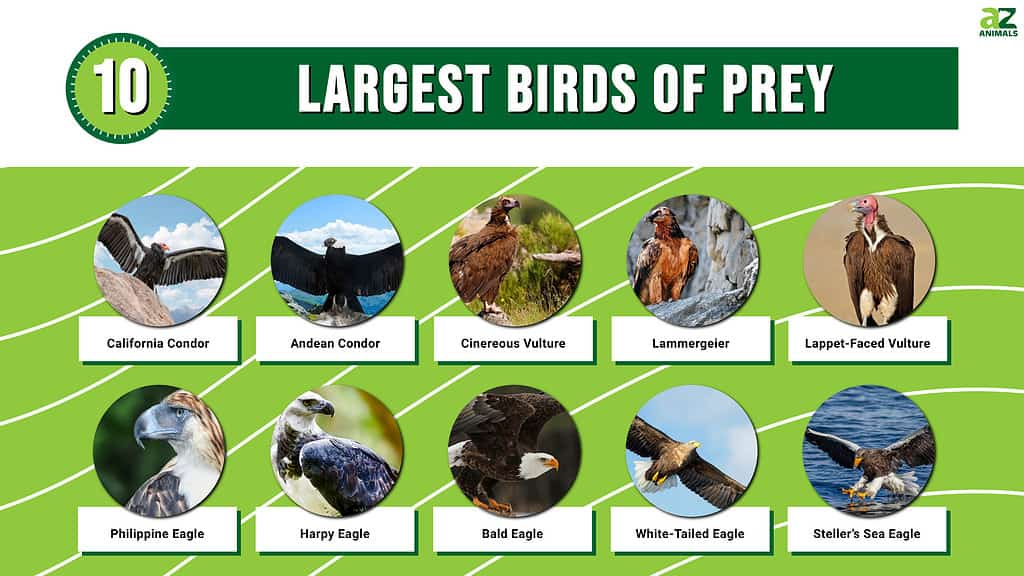
#10 Steller’s Sea Eagle
This huge eagle from the northeastern part of Asia has a bright yellow beak, yellow talons, dark brown feathers with white bands on its wings, white feathers over the thighs and legs, and a white tail. It is considered the heaviest eagle in the world and usually weighs about 11 to 20 pounds. Its talons are formidable, and the feet also possess spicules at the bottom which let the bird hold onto struggling fish.
The fish the Steller’s sea eagle prefers are types of salmon, stickleback, trout, cod, and pollock. The eagle is powerful enough to take large birds such as geese, swans, and even albatross. The conservation status of Steller’s Sea Eagle is vulnerable.

The Steller’s Sea Eagle is the heaviest eagle in the world, weighing up to 20 pounds.
©GUDKOV ANDREY/Shutterstock.com
#9 White-Tailed Eagle
As the bald eagle is found in America, its close cousin the white-tailed eagle is found largely in Russia and Eurasia. It is a sea eagle that usually lives along bodies of water. It is brown and gray all over save its white tail and can range in length from 26 to 37 inches with a wingspan of between nearly 6 feet to 8 feet.
Females usually weigh from around 9 to 15 pounds while males weigh about 7 to 12 pounds.
White-tailed eagles have the largest population of any eagles in Europe and they are often found along the coast of Norway. They tend to hang out near sea lochs although do roam the areas of islands. This behavior is common among young white-tailed eagles. The species is widely seen in Russia as well as Norway.
The eagle can also be recognized by its calls, which sound like a series of yelps. It often scavenges but is an exceptionally agile flyer and has been seen to snatch fish and waterfowl from bodies of water.
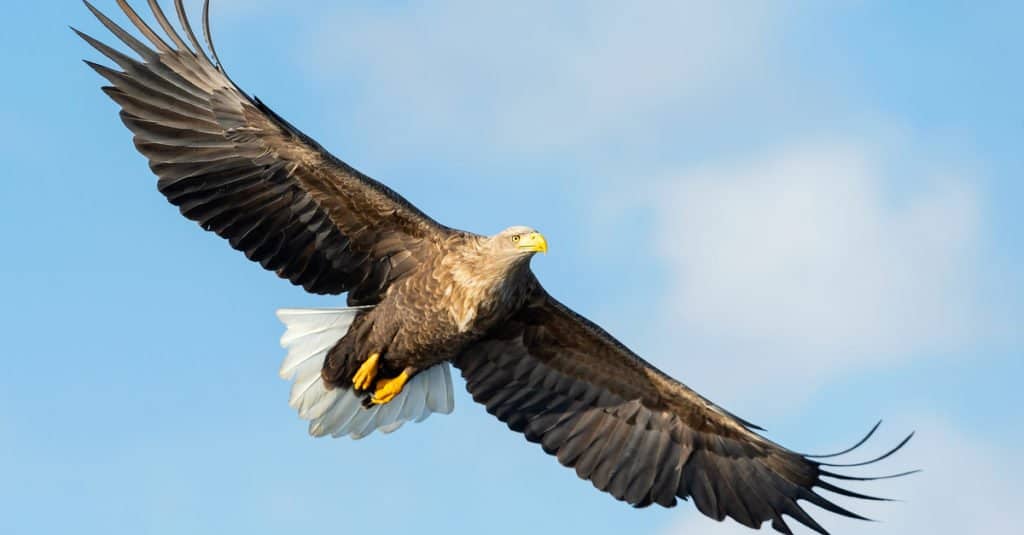
The
White-Tailed Eagle
is found in Russia and Eurasia.
©Sergey Uryadnikov/Shutterstock.com
#8 Bald Eagle
The national bird of the United States and found throughout much of North America, the bald eagle’s pure white head and neck and white tail and rump are very recognizable. It most often catches live prey, including seabirds such as ducks and seagulls, and fish including salmon. Yet the bald eagle is not above scavenging and even stealing food from other animals, especially the smaller Osprey.
It prefers to roost in tall trees, even though it is challenging for this big bird to fly through a dense canopy. It ranges between 30 and 43 inches long, weighs about 9.47 pounds, and has a wingspan between 6 and 7.5 feet. It takes five years for a bald eagle to achieve its unique plumage, and even then it may still have some of the dark feathers of its younger days.
The bald eagle actually carried importance among humans dating back to ancient Rome, when it was used as a symbol for Roman legions who considered it to represent strength. In 1782, five years after the Declaration of Independence was signed, Charles Thompson, the secretary of Congress, was working on nailing down the design for the official seal of the United States of America.
He suggested that a sketch he’d reviewed of a small white eagle be changed to a bald eagle. Since then, the bald eagle has been the national symbol of the USA.
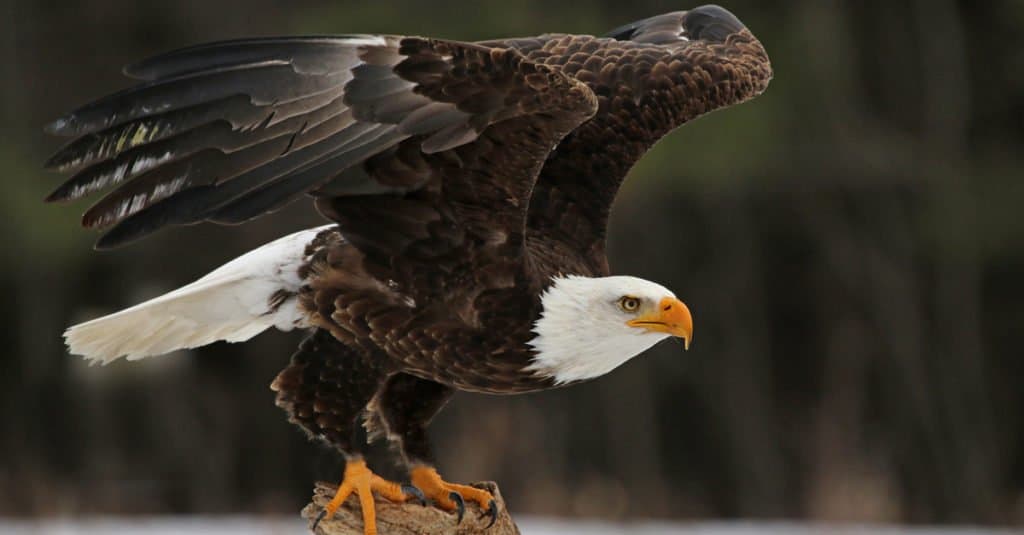
The Bald Eagle is America’s famous national bird.
©Chris Hill/Shutterstock.com
#7 Harpy Eagle
This enormous eagle is renowned for the size of its feet and the fearsomeness of its talons. It is a predator in the rainforests of Central and South America and can be seen flying through the dense trees effortlessly as it hunts possums, snakes, monkeys, and sloths.
Though it’s not the longest eagle, it is one of the largest, with a wingspan of nearly 7 feet and an average length of between 35 and 43 inches. It weighs between 11 and 20 pounds. It’s a striking bird with a slate-colored back, barred, black, and gray tail feathers, light gray head and thighs, and a light-colored breast and belly. The eagle has a crown of feathers that it raises either because it’s threatened or to allow it to hear better or for both reasons. Harpy eagles mate for life and can live between 25 and 35 years in the wild.
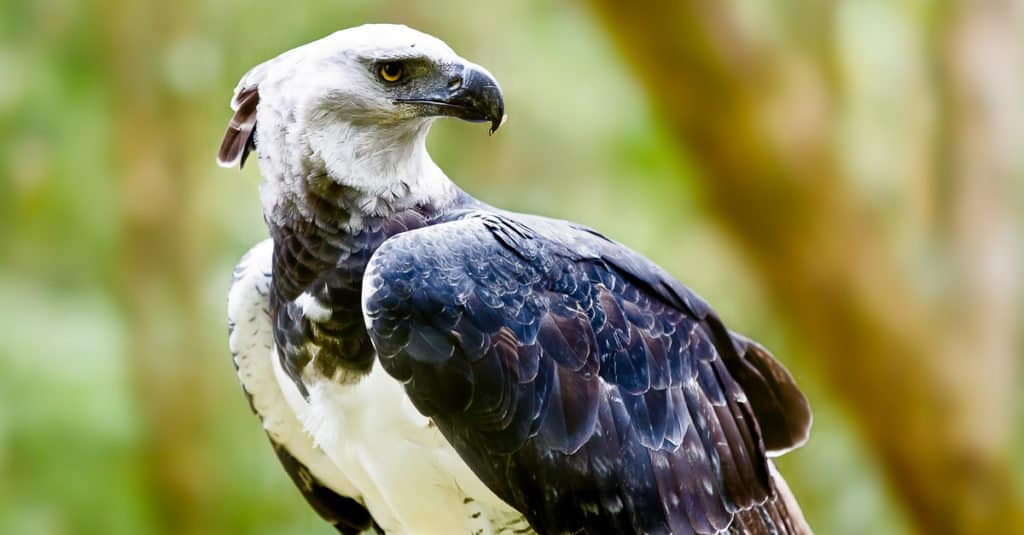
The majestic Harpy Eagle can live up to 35 years in the wild.
©MarcusVDT/Shutterstock.com
#6 Philippine Eagle
As its name states, this eagle is found in the Philippines and lives in the rainforest. Because of this, it has a more slender silhouette than most eagles, but it is one of the biggest raptors at around 37 inches long. The bird weighs between 8.9 to 17.6 pounds. It’s brown on top with a white belly and throat, and its wings are large and have round tips. It also has a brown and white crest, yellow legs, powerful talons, and a large, curved beak. The bird’s beak and talons allow it to seize any prey it can handle, from monkeys to rats to birds to small deer. Though this eagle is revered and is the national bird of the Philippines, it’s still critically endangered due to habitat destruction.
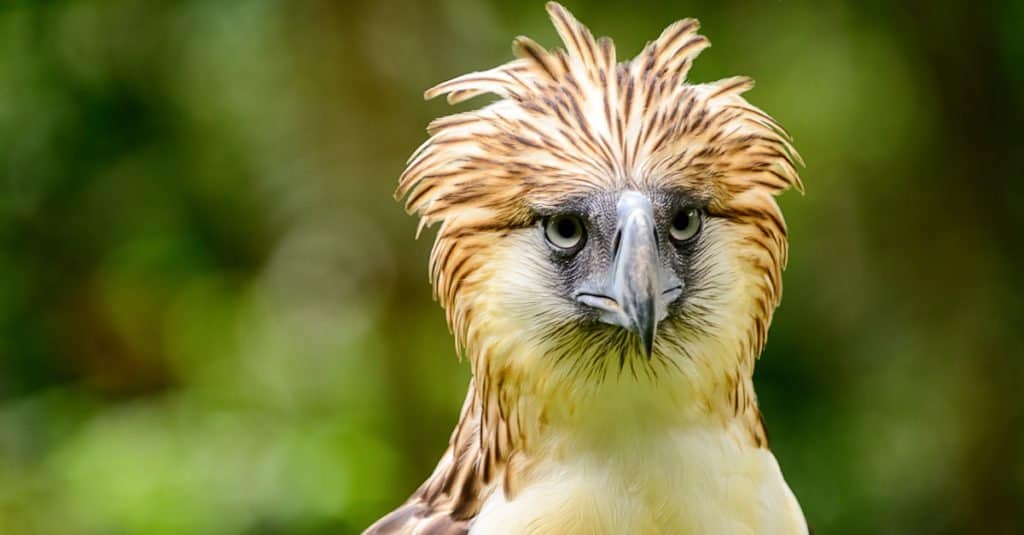
The Philippine Eagle has a unique look that helps it blend in with the environment.
©Alaz/Shutterstock.com
#5 Lappet-Faced Vulture
This vulture, also called the Nubian vulture, has two subspecies. One lives in much of Africa while the other is found in the Middle East. It prefers dry, open areas though it can also be seen now and then near human dwellings in search of roadkill. It’s a cousin of the cinereous vulture and is just a little smaller at 37 to 45 inches long with an 8 to 9.5-foot wingspan.
Like other vultures, this one has a bald head, but its skin is wrinkled and folded, which gives the bird its name. The vulture is not only big but aggressive and will often take over a carcass from smaller vultures. This benefits both vultures because the lappet-faced is strong enough to tear open the tough hide of animals such as an elephant or buffalo. In doing this, the lappet-faced vulture and other animals can partake of the meat.
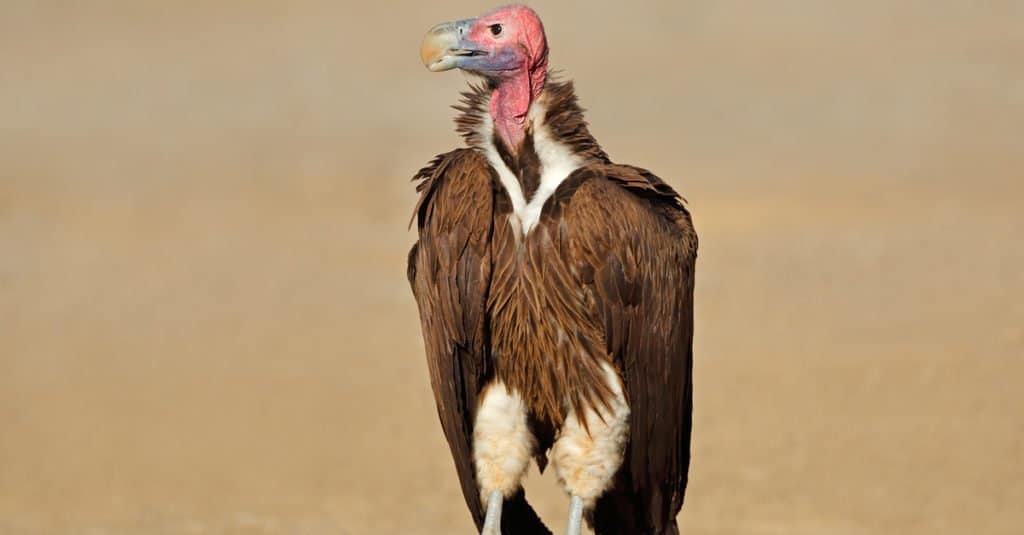
The Lappet-Faced Vulture is known to be aggressive and is famous for its wrinkled skin.
©EcoPrint/Shutterstock.com
#4 Lammergeier
This bird of prey is also called the bearded vulture, but it’s more closely related to eagles and hawks. Indeed, its head is fully fathered, even though it does eat carrion. There are 13 subspecies that are found throughout Africa, Spain, India, Tibet, parts of China, and Siberia. It resides in the mountains, which gives it a good view of prey animals, especially those that have been freshly killed by predators.
These huge birds range in length from 37 to 49 inches and have a wingspan between 7.6 and 9.3 feet. Females are larger. Interestingly, lammergeiers sometimes form threesomes, with two males vying for the same female. They’re also different from other vultures in that they bring pieces of prey to their chicks as opposed to regurgitating them.
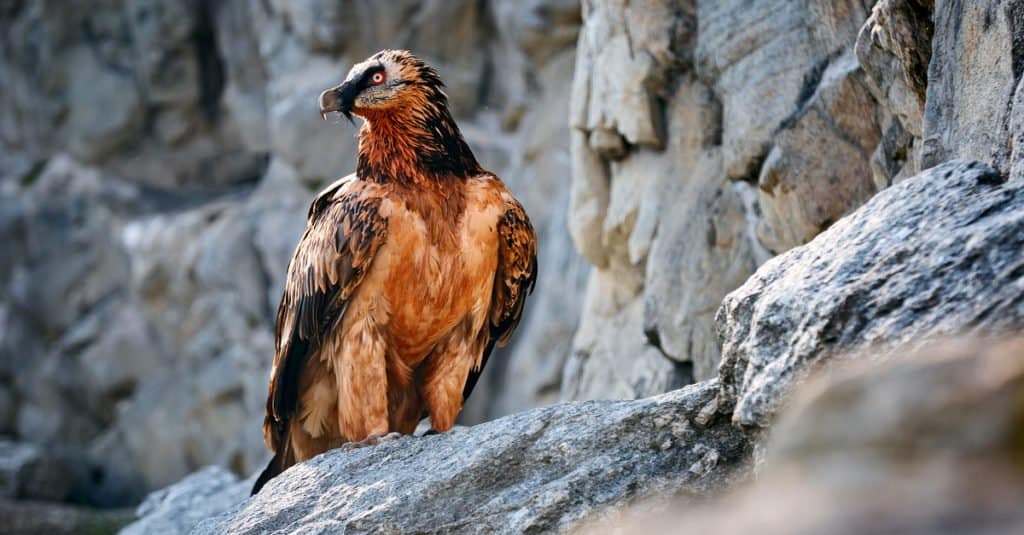
The Lammergeier sometimes forms threesomes with two males competing for the same female.
©Petr Salinger/Shutterstock.com
#3 Cinereous Vulture
This vulture is one of the biggest of the Old World vultures. Also called the black vulture or monk vulture, this bird can be almost 4 feet long, weigh around 30 pounds, and have a wingspan that’s a little over 10 feet. It is not only one of the largest of the flying birds but one of the heaviest. It’s found from Spain down into the Middle East and east into China and Mongolia.
Its body is covered with brown feathers, and it has bluish-gray skin. The bird’s head has a fine, dark color, and when it’s flying the bird can seem completely black to a person on the ground. This illusion gives it one of its names. These vultures, which nest on cliffs, are devoted parents, and their well-fed chicks can weigh more than their parents by the time they fledge.
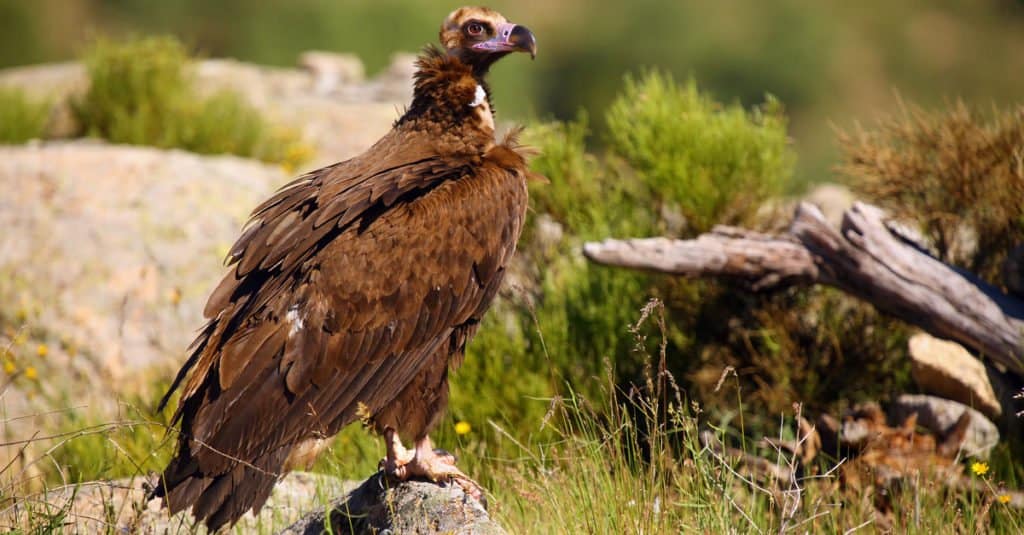
The Cinereous Vulture is one of the most affectionate parents.
©Karel Bartik/Shutterstock.com
#2 Andean Condor
Though the Andean Condor is about 2 inches shorter than the California condor, it is heavier and has an even longer wingspan. The Andean condor can weigh as much as 33 pounds and have a wingspan from 9 to a little over 10 feet. The female is smaller than the male, which is unusual for raptors. She also differs from him in that he has a comb and a wattle while she doesn’t. Males also have brown eyes while the eyes of females are red.
Like other vultures, they both have naked heads and necks, which makes it less messy to plunge their heads into the innards of rotting carcasses. They can also change the color of the skin of their head and neck according to their mood. This condor is found in the mountains and deserts of western South America.
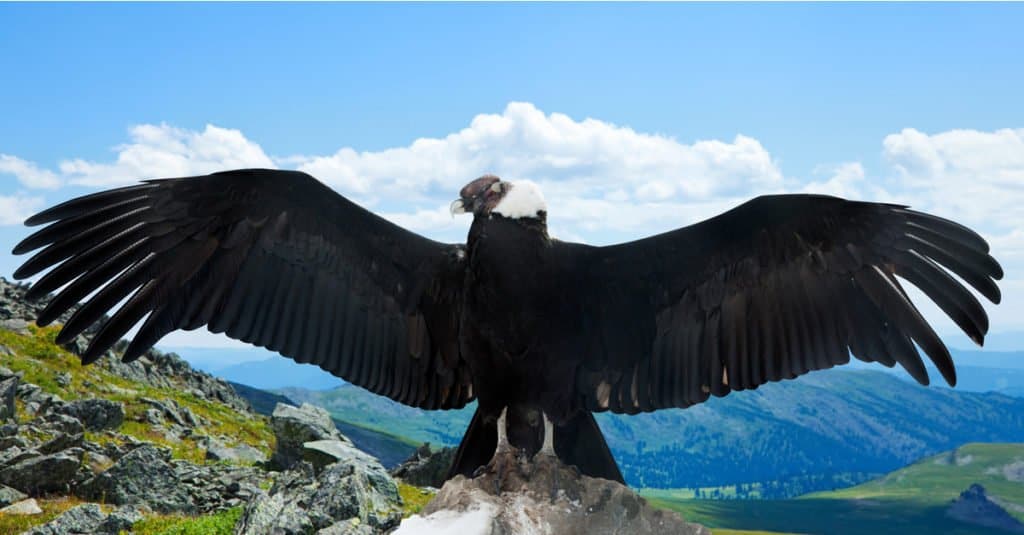
Andean Condors can change the color of their skin according to their mood.
©BearFotos/Shutterstock.com
#1 California Condor
At between 46 and 55 inches from its head to its tail, the California condor is the largest bird of prey in the Americas. It can weigh as much as 23 pounds and have a nine-and-a-half-foot wingspan. Its head and neck are naked except for some black feathers on the forehead and the ring of black feathers around the neck. This bird of prey was once found up and down the west coast of North America but now is found only in the deserts of south-central California.
California condors, who do mostly eat carrion, are fastidious about their persons and spend much time grooming and preening themselves. A California condor can live as long as 45 years in the wild.

The California Condor can live for as long as 45 years.
©MTKhaled mahmud/Shutterstock.com
Summary of the 10 Largest Birds of Prey
Here’s a review of the birds of prey that make the cut for the largest in the world:
| Rank | Bird of Prey | Average Feet of Wingspan |
|---|---|---|
| 1 | California Condor | 9.5 |
| 2 | Andean Condor | 9 – 10 |
| 3 | Cinereous Vulture | Over 10 |
| 4 | Lammergeier | 7.6 – 9.3 |
| 5 | Lappet-Faced Vulture | 8 – 9.5 |
| 6 | Philippine Eagle | 6 – 7.3 |
| 7 | Harpy Eagle | Almost 7 |
| 8 | Bald Eagle | 6 – 7.5 |
| 9 | White-Tailed Eagle | 6 – 8 |
| 10 | Steller’s Sea Eagle | 6.4 – 8.2 |
Rarest Bird of Prey

The Philippine Eagle is the rarest bird of prey on Earth.
©iStock.com/LaserLens
With fewer than 300 breeding pairs left in the wild, the Philippine eagle is considered the rarest bird of prey in the world. Large-scale habitat loss from commercial logging, pressure from development, forests converted to agriculture and human persecution continue to threaten the Philippine eagle population. Many of the eagles were killed when super typhoon Yolanda hit the region in 2013.
The indigenous Dumagat people are hoping to get their native forest declared a protected habitat for the Philippine eagle. If this is accomplished, it could preserve their way of life and establish a protected habitat for the eagle. Their ancestral domain stretches 22 miles against the Pacific Ocean in the Aurora province.
What Bird of Prey was Big and Strong Enough To Prey on Humans?
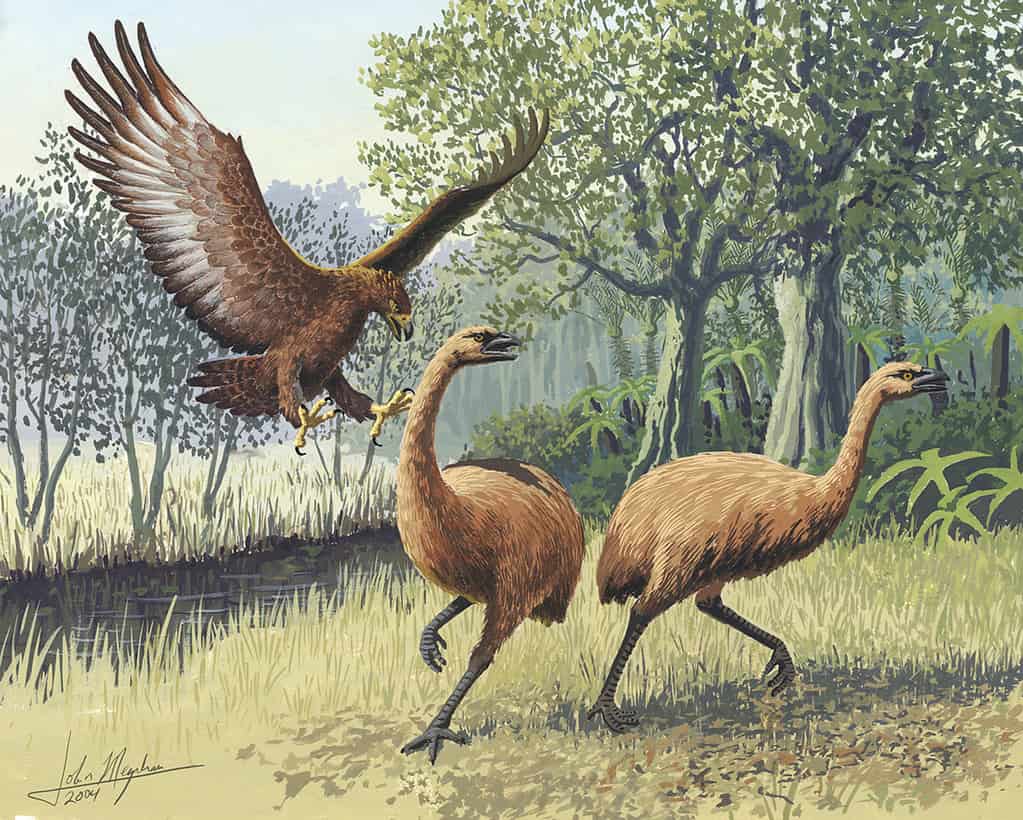
The Haast’s eagle possessed a body and wings of a massive eagle, legs and a bill stronger and larger than the largest existing vulture species, and feet and claws as big as those of a current
tiger
.
©Ancient DNA Tells Story of Giant Eagle Evolution. PLoS Biol 3(1): e20. doi:10.1371/journal.pbio.0030020.g001 – Original / License
Many of the birds that are on this list truly are large enough to fight and harass a human, but none are actually strong and bold enough to attempt it to the point where one would claim that they prey on people. Defending territory and protecting a nest is one thing, but hunting is another matter all together.
With that being said, there once existed a bird of prey that was known for this to be contrary. This bird was called the Haast’s Eagle (Harpagornis moorei). This massive avian lived in New Zealand and is claimed to have become extinct before the 1500s. A reason for this could be the Maori settling on the islands.
The Haast’s Eagle is thought to have attacked and fed upon their prey, often moa, on the ground, whereas many other birds of prey would fly off with their kill. These eagles, however, ambushed moa that outweighed them by ten times!
The photo featured at the top of this post is © Niclas Halvorsen/Shutterstock.com
Thank you for reading! Have some feedback for us? Contact the AZ Animals editorial team.







